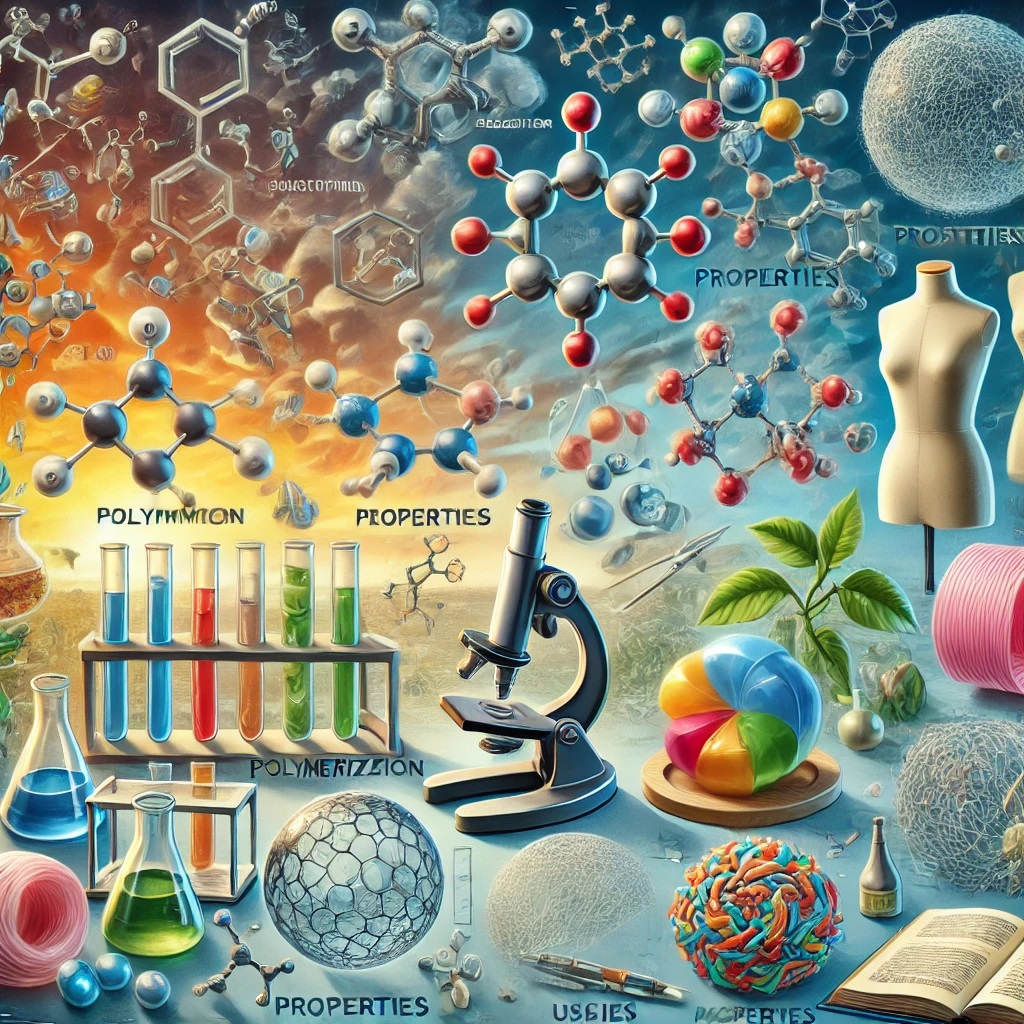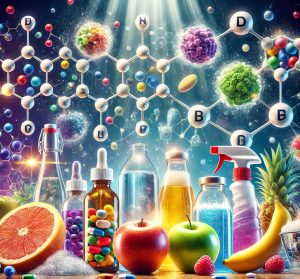Polymerization, Properties, and Uses of Polymers
Polymers are large, complex molecules composed of repeated subunits called monomers. The process of polymerization, which refers to the chemical reactions that lead to the formation of polymers, plays a crucial role in the creation of synthetic and natural polymers that have a wide array of properties and uses. Understanding polymerization, the properties of polymers, and their applications is essential for comprehending how these materials are used in various industries, ranging from packaging and medicine to electronics and automotive parts. This comprehensive analysis covers the key aspects of polymerization, polymer properties, and the wide-ranging uses of polymers.

1. Polymerization
Polymerization is a chemical process in which small molecules called monomers join together to form a large molecule or macromolecule known as a polymer. The process of polymerization involves the breaking of chemical bonds in the monomers, allowing them to link together into a long, chain-like structure. There are two primary types of polymerization processes: addition polymerization and condensation polymerization.
1.1 Addition Polymerization (Chain-Growth Polymerization)
Addition polymerization involves the addition of monomers with unsaturated bonds (typically double bonds) to form a polymer. During this process, the monomers react with one another, breaking their double bonds and forming new single bonds with adjacent monomers. The polymerization occurs without the release of by-products.
Key Steps in Addition Polymerization:
- Initiation: A free radical, cation, or anion is generated, which can break the bond in the monomer, creating an active site that reacts with other monomers.
- Propagation: The active site of the growing polymer chain reacts with more monomers, extending the chain.
- Termination: The polymerization process halts when two growing polymer chains combine or when the active site is deactivated.
Examples of Addition Polymers:
- Polyethylene (PE): Used in plastic bags, bottles, and toys.
- Polystyrene (PS): Used in disposable cups, packaging, and insulation.
- Polypropylene (PP): Found in automotive parts, containers, and textiles.
1.2 Condensation Polymerization (Step-Growth Polymerization)
In condensation polymerization, monomers with two or more functional groups react to form a polymer while releasing small molecules, such as water, methanol, or hydrogen chloride. This type of polymerization typically occurs in a step-growth manner, where the polymer grows gradually as the reaction continues.
Key Features of Condensation Polymerization:
- The process involves the reaction of monomers that contain two or more functional groups.
- Unlike addition polymerization, condensation polymerization releases by-products during the reaction, often in the form of small molecules.
- The polymer chains grow step by step, with each step involving the linking of monomers.
Examples of Condensation Polymers:
- Nylon: A synthetic polymer used in textiles, ropes, and automotive components.
- Polyesters: Used in fabrics (e.g., PET used in clothing and plastic bottles).
- Polyurethanes: Used in foams, adhesives, and coatings.
2. Properties of Polymers
Polymers exhibit a wide range of properties depending on their molecular structure, degree of polymerization, and the nature of their chemical bonds. The properties of polymers can be categorized into physical properties, thermal properties, mechanical properties, and chemical properties.
2.1 Physical Properties
- Molecular Weight: The molecular weight of a polymer is directly related to its length or size. Polymers with a higher molecular weight generally have better mechanical properties, such as strength and durability.
- Crystallinity and Amorphousness: Some polymers, like polyethylene, have crystalline regions where the polymer chains are highly ordered, while others, like polystyrene, are amorphous and lack long-range order. Crystalline polymers tend to have higher density, strength, and resistance to chemicals.
- Density: The density of a polymer can vary depending on its structure. Linear polymers usually have a lower density, while cross-linked polymers are denser and stronger.
2.2 Thermal Properties
- Melting Point: Crystalline polymers have a well-defined melting point, while amorphous polymers soften over a wide temperature range. The melting point of a polymer is influenced by its molecular weight and crystallinity.
- Glass Transition Temperature (Tg): This is the temperature at which an amorphous polymer transitions from a hard, glassy state to a soft, rubbery state. Polymers with low Tg values are more flexible, while those with higher Tg values are more rigid.
- Thermal Stability: Polymers may degrade at high temperatures, and the thermal stability depends on their chemical structure. Thermosetting polymers, for example, are more thermally stable than thermoplastics.
2.3 Mechanical Properties
- Tensile Strength: This is the maximum stress a polymer can withstand while being stretched. Polymers such as nylon and polyethylene have high tensile strength, making them suitable for applications like ropes and plastic containers.
- Elasticity and Flexibility: The ability of a polymer to return to its original shape after being deformed is a key mechanical property. Elastomers, such as rubber, exhibit high elasticity and flexibility.
- Hardness: This refers to a polymer’s ability to resist indentation or scratching. Cross-linked polymers generally exhibit higher hardness than linear polymers.
2.4 Chemical Properties
- Solubility: Some polymers dissolve in solvents, while others do not. The solubility of a polymer depends on its chemical structure and the solvent used.
- Chemical Resistance: Polymers such as polyethylene and polypropylene are highly resistant to chemicals, making them suitable for use in corrosive environments like pipes and chemical tanks.
- Hydrophilicity and Hydrophobicity: Certain polymers, such as cellulose, are hydrophilic (water-attracting), while others, like polytetrafluoroethylene (PTFE), are hydrophobic (water-repelling).
3. Uses of Polymers
Polymers are used in virtually every aspect of daily life due to their versatility, cost-effectiveness, and ability to be engineered to have specific properties. Below are some key applications of polymers in various industries:
3.1 Packaging Industry
Polymers are widely used in the packaging industry due to their durability, lightweight, and flexibility. Plastics such as polyethylene, polypropylene, and polystyrene are commonly used for making bottles, containers, and packaging films. These polymers help preserve food and beverages by providing barrier protection and extending shelf life. Polyethylene terephthalate (PET) is commonly used for making plastic bottles for beverages and other liquid products.
3.2 Automotive Industry
Polymers are used in the automotive industry to reduce weight, improve fuel efficiency, and enhance vehicle safety. Polymers like polypropylene and polycarbonate are used in the production of bumpers, dashboards, and other components. Polyurethane is used in foam seats and insulation materials. Additionally, nylon is employed in making lightweight, durable engine parts, gears, and bearings.
3.3 Biomedical Applications
Polymers are essential in the field of medicine, particularly in the development of medical devices, drug delivery systems, and biodegradable implants. Polylactic acid (PLA) and polyglycolic acid (PGA) are biodegradable polymers used for making surgical sutures, drug delivery devices, and tissue engineering scaffolds. Silicone is commonly used in medical implants and prosthetics due to its biocompatibility and flexibility.
3.4 Textile Industry
In the textile industry, synthetic polymers like nylon, polyester, and spandex are used to make fabrics, garments, and upholstery. Nylon is known for its strength and durability, polyester is used for its wrinkle resistance and low moisture absorption, and spandex is valued for its elasticity and stretchability. Polymers allow for the creation of lightweight, durable, and moisture-resistant fabrics.
3.5 Electronics Industry
Polymers play a crucial role in the electronics industry, particularly in insulating wires and cables, circuit boards, and display technologies. Polyimide is used in flexible circuits, polyethylene is used for wire insulation, and polytetrafluoroethylene (PTFE) is used in connectors and insulation due to its high resistance to heat and chemicals. Conductive polymers are used in organic light-emitting diodes (OLEDs) and organic solar cells.
3.6 Construction Industry
Polymers are used in construction materials for their ability to enhance strength, durability, and water resistance. Polyvinyl chloride (PVC) is used in pipes, window frames, and flooring. Polyurethane foams are used for insulation, while epoxy resins are used in adhesives and coatings to protect surfaces from corrosion and wear.
10 Questions and Answers related to Polymerization, Properties, and Uses of Polymers:
1. What is polymerization?
Answer: Polymerization is the chemical process in which small molecules called monomers bond together to form large, chain-like molecules known as polymers. The process involves the formation of covalent bonds between monomers, resulting in a macromolecule. There are two primary types of polymerization: addition polymerization and condensation polymerization.
2. What are the two main types of polymerization?
Answer: The two main types of polymerization are:
- Addition Polymerization: Monomers with unsaturated bonds (typically double bonds) undergo polymerization, linking together without releasing by-products. Examples include the polymerization of ethene to form polyethylene.
- Condensation Polymerization: Monomers with two or more functional groups react, releasing small molecules like water or methanol as by-products. An example is the formation of nylon from diamines and dicarboxylic acids.
3. What is the difference between thermoplastic and thermosetting polymers?
Answer:
- Thermoplastics: These polymers soften when heated and can be remolded multiple times. They are recyclable and include materials like polyethylene and polypropylene.
- Thermosetting Polymers: These polymers undergo an irreversible curing process when heated, forming a rigid structure that cannot be re-melted. Examples include Bakelite and epoxy resins.
4. What are the key properties of polymers?
Answer: The key properties of polymers include:
- Physical Properties: Includes molecular weight, crystallinity, density, and solubility.
- Thermal Properties: Includes melting point, glass transition temperature (Tg), and thermal stability.
- Mechanical Properties: Includes tensile strength, elasticity, hardness, and impact resistance.
- Chemical Properties: Includes chemical resistance, biodegradability, and reactivity with solvents or environmental factors.
5. What is the significance of cross-linking in polymers?
Answer: Cross-linking refers to the formation of chemical bonds between polymer chains, creating a three-dimensional network. This increases the strength, rigidity, and resistance to heat and solvents. Cross-linked polymers, like vulcanized rubber, are more durable and stable compared to linear polymers.
6. How are polymers used in the packaging industry?
Answer: Polymers like polyethylene, polypropylene, and polystyrene are extensively used in the packaging industry due to their durability, lightweight nature, and flexibility. They are used in plastic films, containers, bottles, and packaging materials, offering protection for goods while being cost-effective. Polyethylene terephthalate (PET) is commonly used in beverage bottles.
7. What is the role of polymers in the biomedical field?
Answer: Polymers play a critical role in biomedical applications such as medical devices, drug delivery systems, and biodegradable implants. Polymers like polylactic acid (PLA) and polyglycolic acid (PGA) are used in biodegradable surgical sutures, drug release systems, and tissue engineering scaffolds. Silicone polymers are widely used for implants and prosthetics due to their flexibility and biocompatibility.
8. What are elastomers and how are they different from other polymers?
Answer: Elastomers are a type of polymer that exhibit high elasticity, meaning they can undergo significant deformation (stretching) and return to their original shape. Unlike other polymers, which may remain rigid, elastomers are flexible and can be stretched considerably. Examples include rubber and silicone elastomers, used in products like tires, gaskets, and medical devices.
9. What are the environmental impacts of synthetic polymers?
Answer: Synthetic polymers, especially non-biodegradable ones like polyethylene and polypropylene, can cause significant environmental issues. These polymers accumulate in landfills, contributing to pollution and environmental degradation. However, efforts are being made to develop biodegradable polymers (e.g., polylactic acid, polyhydroxyalkanoates) to reduce plastic waste. Additionally, recycling processes are being improved to manage polymer waste more effectively.
10. What are the uses of polyethylene (PE)?
Answer: Polyethylene (PE) is one of the most commonly used synthetic polymers. It is widely used in:
- Packaging: In plastic bags, films, and containers due to its flexibility and durability.
- Medical: For sterile packaging and disposable medical devices.
- Construction: In pipes, insulation materials, and geotextiles.
- Consumer Products: Including toys, containers, and household items.






